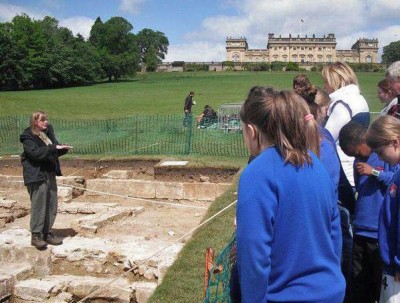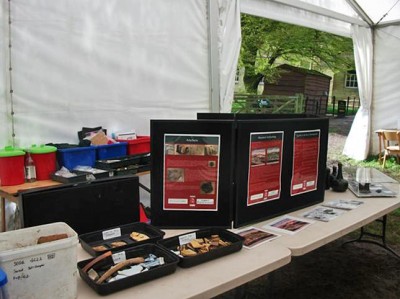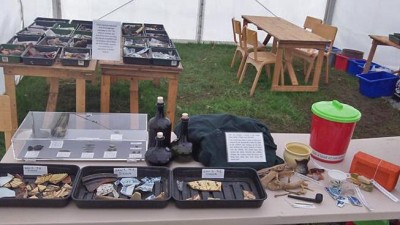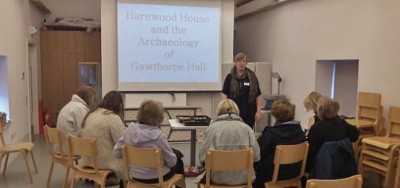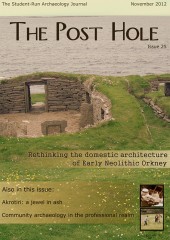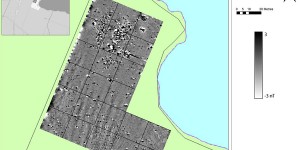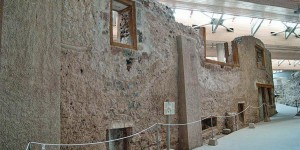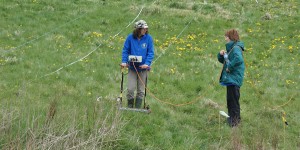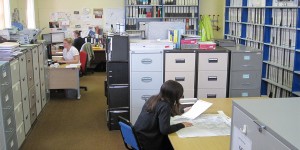This article aims to provide a background to the public engagement programme which has been developed between Harewood House Trust and The University of York’s Department of Archaeology, through the excavations of Gawthorpe Hall.
Gawthorpe Hall, within the grounds of Harewood House, has been one of the excavation sites of York’s undergraduate fieldschools since 2011. In 2009, before the fieldschool began at Gawthorpe, the Harewood Project, headed by Dr. Jonathan Finch, excavated small trial trenches over anomalies which had been located from a geophysical survey of the site. Opening these trenches helped to establish the condition and depth of the archaeology which could inform the further excavation of the site. It also uncovered the potential to communicate a new story at Harewood House.
During 2008-2010 the focus of public engagement at Gawthorpe was primarily concerned with providing guided tours of the trial excavations. These were tied into events at Harewood such as the Council for British Archaeology’s ‘Festival of British Archaeology’, and the 250th anniversary of the laying down of the foundation stone of Harewood House, by the Harewood House Trust. The land in which the remains of Gawthorpe Hall sit belong to the Harewood Estate and are privately rented throughout the year, so these tours allowed visitors controlled access to the site which is usually off limits to the public.
In 2008, along with participating country houses – Brodsworth Hall, Burton Constable and Temple Newsam – an exhibition at Harewood House titled ‘Work and Play: life on the Yorkshire country house’, was designed to focus on the people who worked and lived on the Harewood estate in the past. This was directed by Dr. Jonathan Finch and provided an opportunity for Collaborative Doctoral Award PhD student, Timur Tatlioglu to communicate his research (Tatlioglu 2010) which was focused on biographies of people and places within the Harewood Landscape, during the 18th and 19th centuries.
As the excavations of Gawthorpe Hall expanded, so too did the possibilities for using the excavation as a tool to communicate a history of Harewood, different to the narrative told by, and in, the house itself.
Harewood House is run as a charitable education trust and is dedicated to improving education and audience development. The Trust works extensively to provide a range of formal educational sessions to schools, colleges and further and higher education providers (Auty 2010). These include workshops, events, teaching resources, and worksheets which are updated and reinvented to tie in to current exhibitions at Harewood. Resources are also offered to visiting families, children and adult learners, on site and also through material which is available to download through the Harewood House website. Visitors are given details of tours, talks, and workshops which might be running during their visit as they initially enter the site, and are handed printouts and maps with these details on. Alongside these resources, special singular day or festival events provide the main point of contact for public engagement at Harewood.
In 2011, Emily Rayner as part of her Collaborative Doctoral Award PhD began working closely with the Learning team at Harewood. Emily’s research is concerned with the transformation of the landscape from the medieval manor of Gawthorpe to the 18th century estate of Harewood House, with specific focus on the development and eventual destruction of Gawthorpe Hall.
During the first year of the fieldschool at Harewood, the success of previous tours was again implemented to allow visitors to get closer to the archaeology of the site. Not only did the tours allow visitors to see the small finds as they were being pulled out of the ground, but it also gave them an insight into the process of their recovery. Many of the questions from visitors were concerned with how archaeologists know where to excavate, how we know what tools to use, and how we make sense of all the layers of different features which the visitors could see being uncovered as they toured the site. Students during the 2011 season presented an update of the work in their trench during the daily tours, while Emily gave an overview of the site history, showed visitors copies of historical prints of the hall, provided an overview of the aims of the research and some initial interpretations, and guided visitors safely around a working archaeological site.
Working closely with Harewood House Trust during the 2011 season also provided an opportunity to gain skills and knowledge from the Learning team about the experiences of working with school groups. Alongside Anna Wiseman and Jennifer Auty, Emily developed a programme of activities which could be delivered to groups of Key Stages 1-2 and 3-4 children, young adults and adult groups. These workshops were designed with the national curriculum in mind, and aimed to provide an exciting opportunity for people who might never have visited an archaeological excavation before. They were designed so that school groups could develop understanding and skills to analyse their local history from an archaeological and landscape approach, which they might not have considered before.
As the workshops were designed for school groups of up to thirty students of mixed ability and needs, a variety of visual, audio and tactile techniques were developed to keep the whole group engaged (Figure 1). Visual activities included watching a video of archaeologists at work (as well as seeing our own students later in the day), placing pictures of key events in the story of Gawthorpe Hall on a timeline to understand the chronology of the site, and a Horrible Histories style cartoon of the life and untimely death of the 1st Earl of Strafford who had owned Gawthorpe during the 17th century.
Audio learners benefitted from small group and class discussions; for example, what certain artefacts could have been used for, who might have used them and what these might be able to tell us about life in the hall.
Archaeology particularly lends itself to tactile learning techniques and the handling sessions and finds washing at Gawthorpe have been particularly popular. The school groups during the 2011 season were all from the local area and their involvement with the post-excavation of finds gave them a real sense of ownership over the history of a landscape many of them know well and visit regularly.
As well as being fun, fairly complex theoretical ideas were able to be explored with groups of children using these learning techniques. For example, a group of Year 4 (eight and nine year old) students from Harewood Primary School, whilst handling finds and identifying what they might be, discussed the idea of a ‘familiar past’ (Tarlow and West 1998, 2), the bias of pre-constructed ideas of recent history based on our own use of objects in the present. These workshops provided an opportunity for the children to explore ideas, and to learn and communicate their interest in a constructive way. The impact of these workshops has been that these students have returned during subsequent excavations with friends and family, and have been able to share their experiences and describe what is happening on the site, with little help from the official tour guides!
After the success of the 2011 season, funding became available through the Researcher Development Team for PhD students to develop programmes of public engagement, and the Gawthorpe Hall excavation was awarded a full funding of £2,430. In a practical sense this funding allowed permanent teaching resources to be bought, including replicas for handling sessions, cases and boards for display, and printed materials. It also allowed for provisions to be made to have a larger public presence on site during the 2012 excavation, including having a 10m x 5m marquee on site (Figure 2).
During the three week fieldschool excavation in 2012, the marquee drew 990 visitors, including over 100 people who came on the daily tours of the site. Inside the marquee, students from the 2011 fieldschool: David Altoft, Rebecca Gray, Lisa Harrison, Bethany Hutchings, Aysil Neeson, and Mercy Wilson, had created panels for visitors to find out more about the excavations and the Harewood Project. They designed panels which were eye catching and informative within a very tight brief of 200 words per panel. This brief was outlined by Harewood House Trust and was designed to complement existing displays within the house and grounds. Working together with Emily to provide a consistent voice across the display, seven panels were produced. These covered areas such as the background to the site, the historical events at Gawthorpe Hall, the artefacts uncovered, the use of historical documents alongside the archaeology, and an overview of the project. Accompanying the panels, each of the students also produced a small handout of about 1,000 words which gave more detail about the topics discussed on the panels, along with suggested (accessible) reading, which visitors could take home if they were particularly interested in a certain topic.
As well as boards and handouts, the marquee also contained trays of finds for visitors to handle, replicas of finds from the site, and special artefacts on view in a display case. The finds were accompanied with interpretative labels and the marquee was staffed at all times to ensure that visitors could ask questions about the material on display. The marquee also provided an ideal space for students to begin processing finds from the site, in full view to the public. This provided students with a chance to tell visitors about what they had been finding, and to show visitors the quantity and variety of finds from the 2012 season, allowing visitors to see another stage in the excavation process.
Throughout the 2012 excavation, an hour-long session was offered every day for adults, and for children, to find out more about artefacts, landscapes and the people of Gawthorpe Hall. The children’s activities focused on matching modern day examples to finds excavated from the site through a handling session, and an activity making crop marks in seed trays to demonstrate some of the uses of aerial photography in landscape archaeology (Figure 3). The adult sessions were designed as twenty minute informal talks with the opportunity to handle finds, and see copies of historical documents and maps (Figure 4).
Throughout the 2012 season, the University of York also had a presence at a number of Harewood events, including Museums at Night, Festival of British Archaeology and the Medieval Faire. These have provided an opportunity for the project to be active on-site during times when Harewood has an increased number of visitors coming to find out more about the history of the estate, who might have a particular interest in the research at Gawthorpe Hall. For the Medieval Harewood season, an exhibition was created by Grace Flood and Emily Rayner in the Terrace Gallery. This displayed finds from the excavation, including a silver ring found during the 2011 season, prints and maps of the landscape of Gawthorpe, artist responses to the archaeology, and quotes from the archives about the hall and gardens.
As well as the extensive public engagement programme which has been created, the funding also allowed training sessions to be given to members of Harewood House Trust. These sessions focused on providing House Stewards and volunteers with the skills to present archaeological material to the public. In the house many of the objects cannot be handled, and those that can be are handled infrequently, wearing conservator’s gloves. The first sessions therefore focused on encouraging staff and volunteers to pick up the artefacts, and take a closer look to help them when describing the objects to a public audience. Working together with the staff and volunteers meant the project also benefited from sharing knowledge about visitor needs and experiences.
The next step in the public engagement of the Gawthorpe excavations is to evaluate the impact of this season’s activities. There have been many challenges this year and it is important to learn from these experiences before taking the public engagement programme any further. For example, one major issue that the site faces is its situation within the park. Visitors can currently only access the site through guided tours, or when it is open through specific events. These are both restricted to people able to pay to gain entry to the house and grounds, or to attend these events. Therefore, the impact of this programme is at present, limited to people already visiting Harewood House, or visiting through an organisation, such as a school or local interest group. A possible way to overcome this would be to increase the outreach aspect of the project, and also to improve online content to allow more accessibility to those unable to physically visit the site itself. As with any such project, there is such possibility with the public engagement of Gawthorpe, and this evaluation stage is vital in helping to channel the direction of this for the future.
Bibliography
- anon. nd. ‘Types of Learning Styles’. http://www.learningguide.org/learningstyles.htm [Accessed November 2, 2012]
- Auty, J. (2010) ‘Harewood House Trust: Education and Audience Development Forward Plan’, unpublished
- Tarlow, S. and West, S. (1998) Familiar Past? Archaeologies of Later Historical Britain, 1550-1950. London: Routledge
- Tatlioglu, T. (2010) Biographies of People and Place: The Harewood Estate 1698-1813. Unpublished PhD thesis, University of York


